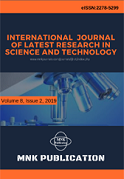DOI:10.29111/ijlrst ISRA Impact Factor:3.35, Peer-reviewed, Open-access Journal
Research Paper Open Access
International Journal of Latest Research in Science and Technology Vol.5 Issue 2, pp 59-64,Year 2016
Correspondence should be addressed to :
Received : 15 April 2016; Accepted : 22 April 2016 ; Published : 30 April 2016

| Download | 125 |
|---|---|
| View | 179 |
| Article No. | 10640 |
Observations have shown the detrimental effects of estrogenic-endocrine disrupting compounds (EEDC) in aquatic ecosystems. These endocrine disruptors remain biologically active at low, environmentally relevant doses, can then be absorbed in vertebrates, and interfere with the normal function of the endocrine system of humans and animals. Two of the major sources of EEDCs in the aquatic environment are Publically Owned Water Treatment Plants (POWTP) and agricultural activity. The objective of this study was to determine the effectiveness of a constructed wetland in ameliorating agricultural runoff containing EEDCs. Water samples were collected from a constructed wetland, a POWTP, and a public water supply lake. The water samples were prepared by solid phase extraction, and the concentrations of the estrogenic steroid hormones estrone, 17β-estradiol, estriol, progesterone, and 17α-ethynylestradiol were determined by HPLC. The results showed that the constructed wetland reduced the concentrations of each of the EEDCs entering the wetland and there was an average reduction of 70% in EEDC concentration before the runoff water was released into the environment. The concentration of EEDCs entering the watershed from the constructed wetland was about almost ten times lower than the concentration entering the watershed from the POWTP.
Copyright © 2016 Brandon Bird et al. This is an open access article distributed under the Creative Commons Attribution 4.0 International (CC BY 4.0) license which permits unrestricted use, distribution, and reproduction in any medium, provided the original work is properly cited.
Brandon Bird, Dalton Gossett, Cran Lucas, Stephen Banks, Patrick Colyer , " The Effectiveness Of A Constructed Wetland In Reducing The Levelsof Estrogenic-endocrine Disrupting Compounds (eedc) In Agriculturalrunoff ", International Journal of Latest Research in Science and Technology . Vol. 5, Issue 2, pp 59-64 , 2016

MNK Publication was founded in 2012 to upholder revolutionary ideas that would advance the research and practice of business and management. Today, we comply with to advance fresh thinking in latest scientific fields where we think we can make a real difference and growth now also including medical and social care, education,management and engineering.

We offers several opportunities for partnership and tie-up with individual, corporate and organizational level. We are working on the open access platform. Editors, authors, readers, librarians and conference organizer can work together. We are giving open opportunities to all. Our team is always willing to work and collaborate to promote open access publication.

Our Journals provide one of the strongest International open access platform for research communities. Our conference proceeding services provide conference organizers a privileged platform for publishing extended conference papers as journal publications. It is deliberated to disseminate scientific research and to establish long term International collaborations and partnerships with academic communities and conference organizers.